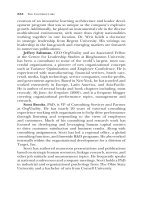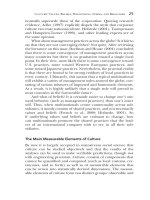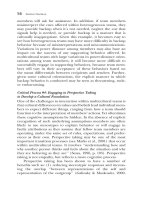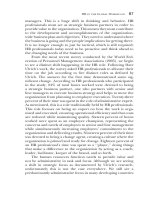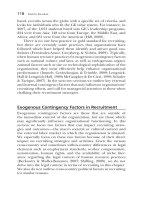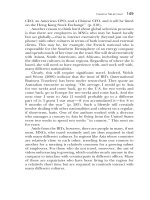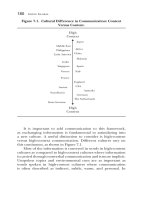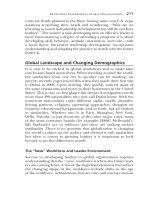Going Global Practical Applications and Recommendations for HR and OD Professionals in the Global Workplace J-B SIOP Professional Practice Series by Kyle Lundby, Jeffrey Jolton and Allen I. Kraut_3 doc
Bạn đang xem bản rút gọn của tài liệu. Xem và tải ngay bản đầy đủ của tài liệu tại đây (504.83 KB, 28 trang )
Navigating the Complexities of a Global Organization 19
policies are guided by local laws and statutes including unions in
the United States and work councils in Europe.
In recent years, organizations now also have to address inter-
national data privacy laws including whistleblower guidelines and
data transfers (EthicsPoint, 2009). In response to the growing
use of technology in database management, and the concern
regarding technology intruding on personal privacy, the European
Union passed a broad law a decade ago that impacts cross-border
transfer of personal data—including HRIS (Human Resources
Information Systems) data. Data privacy laws have tremendous
implications for HRIS databases and the kinds of information that
organizations can collect. Data collected in European countries
cannot be transferred to the United States easily. This law frus-
trates U.S based multinational organizations, the headquarters of
which need to access HR data about their own European work-
force. The EU data laws impose tight restrictions on transferring
personal data outside of Europe, especially to the United States
and other countries whose local laws do not offer EU-caliber pro-
tections. The cross-border transfer restriction is an obstacle for
any organization trying to create a global HRIS.
Data privacy laws have also made some HR-specific operations
more challenging. France, Belgium, Spain, Canada, Germany,
Ireland, and Japan all have data privacy laws which are different
from U.S. laws (Wugmeister, Retzer, & Rich, 2007). This cre-
ates conflicting parameters by which to conduct business. For
example, precoding of demographic information in employee
surveys becomes problematic in countries where data privacy
laws prohibit capturing, and transferring, this information. In
those situations, demographic information must be captured as
self-report data, adding more time for the survey participant. Pre-
coded data adds complexity when not consistently deployed. For
example, ideally an organization should administer an employee
survey in the same manner enterprise-wide to reduce any poten-
tial variance, or noise, in the data. However, if organizations are
looking to provide some ease of use by precoding demograph-
ics, this may work in some countries and not in others. It is
often required to create multiple versions of surveys and other
instruments to accommodate such differences in practice, or to
complicate the single version with assorted caveats regarding ‘‘do
20 Going Global
not complete this information if doing so would be considered
illegal in your country.’’
EU data privacy laws are being enforced with large fines and
criminal penalties such as prison time for the offenders who
commit unauthorized data disclosures. Compliance is key to the
successful transfer of employee data. Organizations can transmit
HR data cross-borders if they implement one of the six EU-
approved tools such as collecting consent from employees and the
safe harbor model (Dowling, 2007).
Summary
The global organization presents a set of complex challenges to
the HR professional in designing, implementing, and managing
global programs. The best practices and recommendations will
be presented in subsequent chapters. The global organization is
a reality and requires embracing a new set of operating principles
to ensure success.
Globalization will be with us forever; there is no going back.
Even though we may have seen some trend toward deglobaliza-
tion or relocalization, the reality is that the world is now more
interconnected than in any previous time. How we manage this
spells the difference between success and failure.
References
Boston Consulting Group (2008). Creating people advantage: How to address
HR challenges worldwide through 2015.
Dowling, D. (2007). Global HR hot topic—Global HRIS and EU data
privacy law compliance. White & Case LLP Newsletters, May 2007.
EthicsPoint (2009). www.ethicspoint.com.
Hempel, J. (2006). Big blue brainstorm. BusinessWeek, August 7, 2006.
Hewitt Associates (2009). Managing HR on a global scale: Findings from
Hewitt’s 2009 Global HR Study.
Kim, S., & Shin, E. H. (2002). A longitudinal analysis of globalization and
regionalization in international trade: A social network approach.
Social Forces, 81(2), 445–471.
Nelson, R. E., & Gopalan, S. (2003). Do organizational cultures replicate
national cultures? Isomorphism, rejection, and reciprocal oppo-
sition in the corporate values of three countries. Organizational
Studies, 24(7), 1115 –1151.
Navigating the Complexities of a Global Organization 21
Sirkin, H. L., Hemerling, J. W., & Bhattacharya, A. K. (2008). Globality:
Challenger companies are radically redefining the competitive
landscape. Strategy & Leadership, 36(6), 36–41.
Solomon, C. M., & Schell, M. S. (2009). Managing across cultures: The seven
keys to doing business with a global mindset. New York: McGraw-Hill.
Wugmeister, M., Retzer, K., & Rich, C. (2007). Global solution for cross-
border data transfers: Making the case for corporate privacy rules.
Georgetown Journal of International Law, 38, 449–498.
Welch, D. E., & Welch, L. S. (2008). The importance of language in
international knowledge transfer. Management International Review,
48(3), 339–360.
CHAPTER 2
Culture: Values, Beliefs,
Perceptions, Norms,
and Behaviors
Vesselin Blagoev
Globalization seems pervasive. So, one might think, the
world’s cultures must be converging into one homogenized
global value system. But they are not. We not only do not
find evidence of convergence—we actually find that the
gap between the value systems of rich and poor countries
has been growing, not shrinking.
—Ronald Inglehart, Chairman of the World Values
Survey Executive Committee
During the 2003 annual conference of the Central and East
European Management Development Association, a keynote
speaker told the audience that there had not been a single
example of a successful French-Dutch joint venture. He attributed
that to the differences between French and Dutch national
cultures. In his words, the Dutch employees of his company,
Martinair, were extremely disturbed by the news of the impending
merger with Air France, as it could result in authoritarian French
management, something that is strongly resented in the
Netherlands. As the speaker explained, the clash between the two
types of management could have emotional as well as financial
consequences. Or consider another case. Heineken NV, one of
the largest beer producers in the world, had a similar problem
22
Culture: Values, Beliefs, Perceptions, Norms, and Behaviors 23
with its French subsidiary. To solve it, that multinational had to
buy 100% of its stock ahead of the time specified in the acquisition
contract and at a huge premium. ‘‘I used this case,’’ the speaker
said, ‘‘to illustrate the fact that the outcome of some joint ventures
can be decided solely by cultural issues.’’ This speaker was not
just some industry researcher but Gerard van Schaik, chairman
of Martinair, former chairman of the board of Heineken NV, and
president of the European Foundation for Management Develop-
ment. His words reflect an observation that is shared by growing
numbers of international managers: If cultural differences are not
properly understood and managed, they can be a major obstacle
to the success of any cross-national venture, especially if it involves
very different cultures. The point of this is not to suggest that
cross-national activities cannot work, because there are success
stories out there. However, culture is pervasive and often operates
at an unconscious level. To successfully manage across cultures,
leaders today—whether they are crossing geographic boundaries
or not—really need to have an appreciation of what culture is,
its ability to influence behavior, and ideally they will have a mind
that is open to different ways of interacting with the world.
This chapter will explain what culture is, how cultural differ-
ences can be studied and understood, and how that knowledge
can be useful to anybody involved in a cross-cultural encounter,
including international managers. More specifically, I will briefly
examine the scientific approach to the study of the main elements
of culture: shared values, beliefs, norms, and behaviors. I will
show how the complex picture that emerges from such analyses
can be simplified so that it is easily understood by nonacademics.
The next section will present some of the main cross-cultural
differences that affect management and organizational behavior.
Finally, I will address the main implications for international
managers.
The reader of this chapter will not find any one-size-fits-all
solutions or quick fixes. After all, culture is as complex and varied
as the organizations in which leaders lead. Instead, this chapter
will provide some serious food for thought, even if this means
that some readers may find it somewhat indigestible. As Geert
Hofstede, one of the world’s most quoted cross-cultural experts,
once put it, studying culture is asking for trouble. A discussion of
24 Going Global
the facts that cross-cultural research has revealed often results in
bruised feelings, indignation, and denial.
Thus, the goal of this chapter is not to tell international
managers how to do their jobs. Rather, it is conceptualized as
a first step of a long psychological process. Somewhere down
this road, after a long exposure to cultural differences, some
international managers naturally find themselves reevaluating
their own values, beliefs, and behaviors vis-`a-vis those in the host
society. Depending upon their particular situation, some may even
need to think about how much of the local culture they can or
should assimilate. After all, cultural traits can be very durable and
resistant to change; we believe that some degree of acceptance
of the host culture is more practical and realistic than trying to
convert the local population. In essence, I believe that becoming
bicultural, or even polycultural, is key to success in international
endeavors. It is not a matter of possessing recipes for specific
situations. It is about being able to see the world through at least
two different pairs of eyes.
What Is Culture?
Culture has been defined in innumerable ways. A good short
definition has been proposed by U.S. anthropologist Donald
Brown: ‘‘patterns of doing and thinking that are passed on within
and between generations by learning’’ (Brown, 1991, p. 130). Hof-
stede’s metaphor (2001)—shared mental software—also gives a
good idea of how culture can be construed. However, the patterns
of doing and thinking, or mental software, represent culture only
if they are durable and are shared by at least some of the members
of a stable group of people, such as a nation or an ethnicity.
Can a large multinational organization have its own distinct
culture and spread it throughout its national branches? Multi-
nationals are interested in promoting a shared culture across
their subsidiaries because it is viewed as some kind of glue that
should help achieve integration and coordination (Schneider,
1988). Yet, the subsidiaries often have an entrenched national cul-
ture that may resist what headquarters would like to impose
(Adler, 1997; Hofstede, 2001; Schneider, 1988; Trompenaars
& Hampden-Turner, 1999). This means that national values
Culture: Values, Beliefs, Perceptions, Norms, and Behaviors 25
normally supersede those of the corporation. Quoting research
evidence, Adler (1997) explicitly dispels the myth that corporate
culture can erase national culture. Hofstede (2001), Trompenaars
and Hampden-Turner (1999), and other leading experts are of
the same opinion.
What about management practices across the globe? Is it fair to
say that they are not converging either? Not quite. After reviewing
the literature on this issue, Dorfman and House (2004) concluded
that there is some convergence of management practices across
many countries but there is no gravitation toward a single focal
point. In their view, most likely there is some convergence toward
U.S. practices, some toward Western European practices, and
some toward Japanese practices. Nevertheless, the practical reality
is that there are bound to be strong residues of local practices in
every country. Ultimately, this means that a typical multinational
will exhibit a variety of management styles around the globe, con-
sisting of various mixtures of imported and homemade elements.
As a result, it is highly unlikely that a single style will prevail in
most countries in the foreseeable future.
And what of beliefs? It is certainly easier to change one’s out-
ward behavior (such as management practices) than one’s inner
self. Thus, when multinationals create commonality across sub-
sidiaries, it mostly consists of shared practices, and not necessarily
values and beliefs (French et al., 2008; Hofstede, 2001). So
if underlying values and beliefs are resistant to change, how
can multinationals promote the shared practices that the lead-
ers of an international company wish to see in all their sub-
sidiaries.
The Main Measurable Elements of Culture
By now it is largely accepted in mainstream social science that
culture can be studied objectively and that the results of the
analyses can be used to make verifiable predictions, though not
with engineering precision. Culture consists of components that
cannot be quantified and compared (such as local customs, cer-
emonies, and so forth) as well as of measurable elements that
can be woven into statistically derived dimensions. The measur-
able elements of culture form two distinct groups: observable and
26 Going Global
invisible. The first group consists of behaviors and practices that
can either be seen directly or deduced from national statistics,
such as suicide rates, murder rates, birth rates, road death tolls,
alcohol and tobacco consumption, and the like. The second group
comprises what is commonly known as values, beliefs, perceptions,
and norms. Because these are studied by means of questionnaires,
the easiest way to understand what they are is to look at how the
corresponding questionnaire items are worded.
• Values are measured by asking the respondents what is
important to them in their personal lives. Studies of values
have revealed for example that religion, work, and family are
far more important to people in some countries than in others
(Inglehart & Baker, 2000; Minkov, 2007).
• Beliefs are measured by presenting the respondents with
statements and asking them if they agree or disagree. For
instance respondents in some countries are far more likely
than other respondents to believe that men make better
leaders than women (World Values Survey, 2006) or that caring
for societal affairs only brings trouble (Bond et al., 2004).
• Perceptions are measured by asking the respondents how they
perceive some abstract aspects of their own lives, such as their
happiness, health, and life satisfaction, or the degree of control
that they think they have over their own lives. Studies of per-
ceptions (World Values Survey, 2006) have revealed enormous
cross-cultural differences.
• Norms are measured by asking the respondents what values
others should have and what they should do or should not do.
Thus, norms can be called values (or desirable behaviors) for
others. It is crucially important to understand the difference
between people’s personal values and the norms that they
prescribe to others. because these may coincide or be diametri-
cally opposed. For example, a person who is striving for power
may advocate submissiveness as a norm for others (Smith,
2006). The two largest cross-national studies of nationally
representative samples, the World Values Survey (2006) and the
Pew Research Center (2002; 2007), have revealed significant
cross-cultural differences in norms, such as the degree to which
respondents agree that poor people should be helped by the
government or their fellow citizens.
Culture: Values, Beliefs, Perceptions, Norms, and Behaviors 27
Are Some Cultural Ingredients Better Than Others?
The bewildering diversity of values, norms, and practices that one
can observe in different societies often brings up the question
of whether some are better than others. The answer, however,
is highly context-specific. For instance, the values that promote
national economic growth in a particular historical period may
not be the same as at different times or even at the same time in a
different society. Thus, unless the context is clearly specified, it is
difficult to evaluate values and norms in an absolute sense.
Some authors, however, downplay the importance of context
or cultural relativism, as it has become known. Dowling and Welch
(2004), for example, promote the idea of universal values, such as
the biblical ‘‘Thou shalt not kill.’’ They ask whether corruption
is really acceptable in a country like Indonesia, even though
it is a relatively common. Their answer is no, on the grounds
that it is ‘‘morally wrong.’’ However, some would argue that this
answer is culturally specific. In some cases, corruption is viewed
quite differently. For example, I know of East Europeans, North
Africans, and Middle Easterners who have expressed indignation
after Western officials declined their bribe offers. From their own
cultural viewpoint, the Western officials had spurned an offer of
collaboration and friendship. In short, the same practice is viewed
very differently as a function of one’s own cultural context.
This is not a call for Western expatriates to engage in corrupt
practices while working outside theirhome countries.Quiteon the
contrary, as already stated, values are very difficult to change and
Westerners cannot be expected to trade theirs for a different cur-
rency just because it appears to be ‘‘semi-legal tender’’ in a foreign
country. I simply use this example to expose the fallacy of the idea
of a universal morality, and to drive home the notion that when
some Western values are served up to people who have not grown
up with them,they maybe as reluctant to adopt themas some West-
erners may be unwilling, or just afraid, to engage in corruption.
Main Cultural Dimensions with Implications
for Cross-Cultural Management
The research literature provides many accounts of cultural dimen-
sions that seem to explain various societal differences, some
of which have implications for management and organizational
28 Going Global
behavior. The following is a brief presentation of those that may be
most useful to an international manager, while being scientifically
sound and reliable.
Individualism versus Collectivism (Universalism
versus Exclusionism)
This is an extremely robust dimension in the sense that it has
appeared in a number of large-scale studies, involving more than
45 nations each, the first of which was that by Geert Hofstede
around 1970 (Hofstede, 2001), followed by Smith, Dugan, and
Trompenaars (1996), Gelfand, Ghawuk, Nishii, and Bechtold
(2004), and Minkov (2007).
There are some divergent opinions concerning the right inter-
pretation of this dimension and what exactly is at its core. Many
view individualism as being synonymous with selfishness and a
preferencetogoit alone.It has alsobeen interpreted ascompetition-
orientation. Collectivism, on the other hand, is often described as
a willingness to follow others, to cooperate, and to work in teams.
However, these concepts are not meaningfully correlated with the
previously mentioned large-scale measures of individualism versus
collectivism, as the latter reveal a different picture.
Individualism versus collectivism also reflects some of the
important differencesbetween Western and non-Western cultures.
Economically poor societies are often thought of as collec-
tivist because they are characterized by strong and cohesive
in-groups, consisting mainly of clansmen, close friends, and rela-
tives, although thecircle may be extended to include other groups,
such as one’s loyal customers and employees. People in collectivis-
tic societies usually feel a strong moral obligation toward in-group
members, which may sometimes assume the form of self-sacrifice.
Out-group members, by contrast, tend to be treated with com-
parative indifference, which can escalate into outright neglect,
negligence, disrespect, derision, and discrimination. In worst-case
scenarios, the result can be open hostility and abuse. As Triandis
(2000) puts it, ‘‘people in collectivist cultures are extremely sup-
portive of their in-group members, but they have a cold, and even
hostile, relationship with out-group members’’ (p. 29).
To avoid misconceptions, and to emphasize the practical impli-
cations of these cultural differences, Minkov (2007) proposed a
Culture: Values, Beliefs, Perceptions, Norms, and Behaviors 29
new name for the individualism-versus-collectivism dimension:
universalism versus exclusionism. Exclusionism (collectivism) can
be viewed as a tendency to treat people on the basis of their group
membership, refusing privileges to out-group members by means
of nepotism and discrimination. Universalism (individualism) is
about the opposite: the degree to which a society is serious about
stamping out nepotism and discriminatory attitudes and practices.
This dimension is also a very strong predictor of corruption, as
measured by Transparency International. Poorer and more exclu-
sionist countries invariably have more corruption. Businesspeople
from a state official’s in-group deserve a preferential treatment
that others are excluded from. If they wish to receive a service or
obtainacontractthatisnotmeantforthem,theonlyrecourse
that they normally have is a bribe.
Shades of gray. It must also be noted that there are shades
of gray with regard to the distinction between individualism and
collectivism. For example, research has shown that the indifferent
or cold attitude toward out-group in collectivistic societies may
disappear in some collectivist countries when strangers are per-
ceived as being in need of help (Levine, Norenzayan, & Philbrick,
2001). Moreover, it would be incorrect to say that the distinction
between in-groups and out-groups is totally unknown in the indi-
vidualistic West, but it is far less pronounced. For example, while
it is clear from the World Values Survey that racism (expressed as
an unwillingness to have neighbors of a different race) is much
stronger in Asia, Africa, the Middle East, and Eastern Europe, the
same survey shows that ‘‘tolerance and respect for others,’’ as a
value that children should learn, is strongest in the West.
Implications for Organizations
Individualism and collectivism have many implications for orga-
nizations, and we now turn to a few of the more obvious or
potentially challenging ones.
Nepotism. Whereas Westerners tend to view nepotism as
morally wrong, it is viewed as more acceptable in poorer exclu-
sionist (individualistic) societies. In those societies, a person can
be dead (literally) without the support of his or her in-group
and is therefore obliged to prioritize commitments in their favor.
30 Going Global
In a poor society with limited resources, this is only natural. By
contrast, refusing preferentialtreatmenttoamemberofone’s
in-group can result in severe sanctions.
As a result, organizations in poor collectivist-exclusionist soci-
eties may look more like families in that personal and professional
relationships are intermixed (Hampden-Turner & Trompenaars,
1996; Trompenaars & Hampden-Turner, 1999). A boss may ask his
subordinates to help him paint his house or run personal errands
for him. He is a father figure who disburses privileges on the basis
of the loyalty and obedience that he receives, not necessarily on
the basis of personally achieved professional goals.
Thus, in exclusionist societies, nepotistic practices can be
quite strong, as are attempts to cover the misdemeanors of in-
group members. ‘‘Nothing personal’’ is a meaningless statement
in this type of culture because nearly everything is personal.
Any direct criticism of an employee’s professional performance
may be interpreted as an assault on his character. Hiring, firing,
and promotions in a company’s hierarchy also reflect the quality
of personal relationships. The idea of sacking an employee for
failing to achieve targets may sound alien. My own consulting
practice shows that when the Western logic of this phenomenon
is explained to people with a strongly exclusionist (collectivist)
mind-set, they find it abhorrent andunworkable. Of course, layoffs
do occur in the poor world during crises, but firing people on the
basis of their mediocre performance, with no concern for their
personal relationship with their manager and peers, can be viewed
as shockingly immoral and incomprehensible.
By contrast, in Western societies, an employee that does not
visibly contribute to the success of the organization is viewed as a
burden that should be jettisoned as soon as possible. A good illus-
tration of the diametrical opposition in management philosophies
that these cultural differences can produce is provided by the nar-
ratives of two of the world’s most famous managers: Jack Welch,
former chief executive of General Electric, and Akio Morita, the
late founder and president of Sony. Welch was proud of a human
resource management system that required the heads of the com-
pany’s different businesses to rank all their managers each year
and lay off the lowest 10 percent (Welch & Byrne, 2001, quoted in
‘‘Jack and the People Factory,’’ 2001, p. 38.). Morita, by contrast,
Culture: Values, Beliefs, Perceptions, Norms, and Behaviors 31
practiced Japanese management, based precisely on the opposite
philosophy. Once he complained to some American colleagues
about an exasperating employee and admitted he did not know
what to do with him. The Americans advised him to fire the
person. ‘‘I was stunned by the idea,’’ Morita wrote, ‘‘I had never
fired anybody and even in this case it had never crossed my
mind. But to solve the problem by firing a man was the Ameri-
can system’’ (Morita, Reingold, & Shimomura, 1986, quoted in
Hampden-Turner & Trompenaars, 1996, p. 175).
Contracting. Universalist (Individualist) societies have a ten-
dency to produce rigid formal contracts that must be respected,
whereas exclusionist ones have a much looser attitude toward
agreements, especially when they involve out-group members
(Minkov, 2007; Trompenaars & Hampden-Turner, 1999). For a
contract to be honored in an exclusionist culture, one may need to
form a very close relationship with one’s business partner, which
effectively guarantees the status of an in-group member (Trompe-
naars & Hampden-Turner, 1999). The universalist cultures of the
rich world and their higher concern for others, regardless of their
group affiliation, have produced formal legislation that makes it
very risky to renege on agreements.
Punctuality. The anecdotal evidence in Trompenaars and
Hampden-Turner (1999), as well as research by Levine and Noren-
zayan (1999), shows that Western cultures differ from the rest
of the world in terms of their greater respect for punctuality
and faster speed of life. This difference has been confusingly
interpreted in terms of a ‘‘synchronic’’ or ‘‘polychronic’’ ver-
sus ‘‘sequential’’ dimension (Trompenaars & Hampden-Turner,
1999, p. 123). In fact, it simply reflects differences in empathy:
lower levels in the poor exclusionist world where people are less
likely to show tolerance and respect for others, higher levels in
the rich universalist world. As Trompenaars (2003) admitted, an
acquaintance of his once made the following statement: ‘‘The
problem of being late is actually the problem of those who are
on time.’’ This means that a lack of punctuality need not be
explained as a different perception of time. It reveals a lack of
empathy and respect for those who are waiting. Similarly, the
so-called polychronic behavior of a clerk in an exclusionist society
who is talking to a friend while dealing with a customer simply
32 Going Global
means that the friend is more important to this person than the
business.
Communication. One of the potentially exasperating differ-
ences between exclusionist and universalist cultures has been
defined as high-context versus low-context communication (Hall,
1959). High-context means beating around the bush: the message is
implicit and parts of it have to be inferred and guessed from the
situation in which it was made or from some external information
about the speaker. Low-context communication involves explicit
statements that leave little room for subjective interpretations.
The fact that Western societies prefer long and precise contracts,
which are atypical in the developing world, owes a lot to this
cultural difference. Western culture is low-context: speaking one’s
mind clearly and precisely and being direct is considered a virtue
as long as one remains polite. But in the high-context exclusionist
world, direct communication of bad news is normally viewed as
rude and inconsiderate. By way of example, Trompenaars and
Hampden-Turner (1999) tell a story about a Western doctor who
was killed by a colleague in a developing country for criticized his
work. Such extreme behavior is very rare but cases when criticising
permanently damages apersonal and professional relationship are
very frequent.
Products, services, and safety. One of the most important
implications of universalism versus exclusionism differences for
international managers is the different attitude toward product
and service quality, as well as safety, in the West and the poorer
parts of the world. Alvazzi del Frate and van Kesteren (2004)
report a study evidencing far more frequent consumer fraud in
exclusionist countries than in universalist ones, whereas Trompe-
naars and Hampden-Turner (1999) quote an IMD report on
international competitiveness that includes a ranking on product
safety in 24 developed economies. There is higher concern for
safety in the rich universalist countries.
This is an extremely serious issue for management. In prin-
ciple, it is multinational companies that bring to the developing
world the idea of consistent product and service quality for all
customers and implement it after some considerable effort. For
example, although Bulgaria is considered the homeland of yogurt,
it was not until Danone set upshop inthat country in the 1990s that
Culture: Values, Beliefs, Perceptions, Norms, and Behaviors 33
Bulgarian customers could finally buy some yogurt of predictable
quality. Even today, the poor and inconsistent quality of many
food products in Bulgarian stores and the fraudulent practices
of quite a few local producers are hotly debated topics in the
country’s media.
Power Distance and Authoritarianism
Power distance, another key component of culture, has been
thought of in different ways. Hofstede (2001), for example, con-
ceptualized this dimension as the emotional distance between
leaders and their subordinates. GLOBE focuses more on the dis-
tribution of power (Carl, Gupta, & Javidan, 2004) and finally,
Euwema, Wendt, and van Emmerik (2007) talk about directive
leadership as the degree to which managers supervise their sub-
ordinates closely and expect precise and immediate execution
of their orders. Despite these differences, the three concepts are
more similar than different. The basic premise is that leader-
follower relationships are more authoritarian in poor countries,
which means that this dimension creates a geographic distri-
bution that tracks closely with individualism and collectivism.
For example, anecdotal evidence suggests that Asia has greatest
authoritarianism, evident in rigid hierarchies and caste systems,
autocratic leadership, and submissive subordinates. The Scandi-
navian countries and the Netherlands, by contrast, are at the
opposite extreme where an employee challenging the decision
of a manager would not necessarily be viewed as shocking or
disrespectful.
For managers crossing these sorts of boundaries, it can be
challenging, to say the least. For example, a manager from north-
western Europe or an Anglo-Saxon country who is not used to
subservient yea-saying subordinates, but expects initiative and
independent action, may find it terribly frustrating to work with
those who prefer to sit back and wait for direction. In a high-
power distance culture, these sorts of qualities are found primarily
in top leaders and entrepreneurs, whereas middle managers
and employees at lower levels are simply supposed to execute
orders. Even senior staff, such as a company’s director of sales
or human resources manager, may be reluctant to make any
34 Going Global
move without the chief executive officer’s blessing. Attempts to
change this type of culture and introduce notions like participa-
tive management, independent decision making, empowerment,
devolution, delayering, and flat company structures often fail
miserably.
And even when one thinks that changes are executed, the
truth could be far different. Examples from Hofstede (2001),
Trompenaars and Hampden-Turner (1999), and my own practice
demonstrate that even when some change is visible at the sur-
face, the underlying situation may remain unchanged. A Slovak
executive from a large German company in Slovakia once told us
that the German leaders had spent a year on a delayering project.
But the final result showed only on the new company chart. In
practice, the old hierarchies remained in people’s minds and
many employees still expected guidance and orders from those
who had been their bosses.
Uncertainty Avoidance
Hofstede’s uncertainty avoidance (2001), in a nutshell, refers to
the way that cultures respond to changes and deal with ambiguity.
High–uncertainty avoidance cultures are generally thought of as
conservative and law-abiding whereas low–uncertainty avoidance
cultures are open to change, innovation, and diversity. There
has, however, been some confusion around rule orientation and
specifically whether or not this is indicative of one’s own personal
values. For example, if personal values guide behavior, then people
in Southern and Latin Europe, where Hofstede’s uncertainty
avoidance reaches its highest scores, should be the most law-
abiding, but many observers have been puzzled by what they
have seen in reality—a seeming South European tendency to
break rules. What are we to make of this? The answer lies in
the difference between personal values and norms for others. In
Bulgaria for instance, the typical philosophy seems to be others
should be very rule-oriented but I must be allowed to break the rules
if it serves my own interest. Thus, while Hofstede’s uncertainty
avoidance may explain how people in some countries react to
other people’s transgressions it does not necessarily tell us about
people’s personal rule orientation.
Culture: Values, Beliefs, Perceptions, Norms, and Behaviors 35
And like anything else, there are shades of gray. For example,
regardless of where they fall on the uncertainty avoidance scale,
no society on earth is without some unbendable rules that every-
body respects. People in southern Europe make more traffic
violations than those in northwestern Europe, but they respect
various other stringent rules that others may not have heard of.
For example, Bulgarians never give a woman an even number
of flowers. Another example: Indonesians drive in a way that
can make a Westerner’s hair stand on end, but they have innu-
merable indigenous social regulations from which they never
deviate.
Masculinity versus Femininity
Hofstede’s ‘‘masculinity versus femininity’’ dimension is also often
misinterpreted, at least in two ways. First of all, it has nothing to do
with male dominance over women, as many people think. Second,
it is not a measure of achievement orientation or competitiveness
in an absolute sense. It is about the prioritization of achievement
versus personal relationships in the workplace. It reveals which
of the two would be more important if employees had to choose
only one of them. According to Hosfstede’s data (2001) from IBM
around 1970, employees in so-called masculine cultures (such
as Japan) attached a higher importance to achievement than to
relationships, whereas the situationin so-called feminine countries
(such as Guatemala) was precisely the opposite. Nevertheless,
Japan’s achievement orientation score was far lower than the
score of Guatemala. In an absolute sense, Guatemala was much
more achievement oriented than Japan.
The World Values Survey, which relies on nationally repre-
sentative data, rather than matched samples from one and the
same corporation, shows a somewhat different pattern of work-
goal prioritization. In the majority of poor countries, the most
important goals are earnings and job security, whereas achieve-
ment and relationships are usually lower on people’s priority lists.
In the United States and Australia, the most important goals are
achievement and earnings; relationships are less important. But
in Japan, Germany, and the Scandinavian countries, relationships
come first.
36 Going Global
Societal Cynicism
Bond and associates (2004) proposed a research-based cultural
dimension called ‘‘societal cynicism.’’ It is measured by responses
to statements such as ‘‘To care about societal affairs only brings
trouble to yourself,’’ ‘‘Kind-hearted people usually suffer losses,’’
‘‘Old people are usually stubborn and biased,’’ ‘‘People will stop
working after they secure a comfortable life,’’ and so on. It
also reflects a view that powerful people are arrogant exploiters.
According to the available data, societal cynicism is strongest
in Eastern Europe, East Asia (Korea, Taiwan), Pakistan, and
Thailand. It is weakest in Norway, the United States, and Canada.
If this relatively new dimension is replicated and confirmed
in further studies, it may have serious implications for interna-
tional management. For example, American managers in Eastern
Europe often wonder why they have to go to unusual lengths to
gain the trust of their subordinates. Societal cynicism may provide
a plausible explanation: in cynical cultures, employees and man-
agers may form oppositional identities that are hard to dismantle.
It is also likely that differences in societal cynicism partly account
for different attitudes toward corruption.
Utilitarian Versus Loyal Involvement
Smith, Dugan, and Trompenaars (1996) studied the norms and
beliefs of 8,841 managers and employees from 43 countries
and identified a dimension they called ‘‘utilitarian versus loyal
involvement.’’ What it measures is the propensity and willingness
to work in a team and share responsibility with others. Their
research revealed that individuals in Asia show the highest level
and Eastern Europeans score lowest. This dimension captures a
phenomenon that any Bulgarian, and probably some other East
Europeans, will be aware of. My colleague Michael Minkov and I
have asked various groups of Bulgarians—business students, com-
pany employees, and even high school students—whether they
like to work in teams, and have often heard a resounding ‘‘no,’’
oftenaccompaniedbyawrygrimace.Attemptsbymanagersfrom
English-speaking countries to change this attitude are not likely
to result in quick success in any society where people prefer to be
given individual tasks and then be left alone.
Culture: Values, Beliefs, Perceptions, Norms, and Behaviors 37
Economic Dynamism
Minkov and Blagoev (2009) have proposed a new cultural dimen-
sion extracted from World Values Survey data. Starting from the
views of leading development economists concerning the deter-
minants of economic growth, and in particular of the East Asian
economic miracle, we show a parallel between the factors pro-
posed by the economists and a number of cultural values. We
demonstrate that nations that attached a higher importance to
thrift and a lower importance to leisure in the 1998–99 wave of
the World Values Survey registered considerably faster economic
growth in the next decade. We also found that these nations attach
a lower importance to personal relationships. The highest scorers
on this dimension, which we called ‘‘economic dynamism,’’ are
East Asian and East European nations. The lowest scorers are the
Latin American countries.
This dimension provides serious food for thought not only
to national governments but also to international managers.
When expatriates from a country that scores high on economic
dynamism become managers in one with a low score, they may
perceive the local workforce as indolent and unacceptably fun-
oriented. Paik and Derick Sohn (1998) quote South Korean
managers in Mexico who were upset by the fact that their work-
ers listened to radios and talked a lot, instead of concentrating
on their work without getting distracted, which seems to be the
normal state of affairs in South Korea.
Project GLOBE’s Leadership Dimensions
During the 1990s, Project GLOBE studied the preferred lead-
ership style in 62 societies (House et al., 2004). The results
specific to leadership from this study are presented in Dorfman,
Hanges, and Brodbeck (2004). Six preferred leadership dimen-
sions were extracted, describing broad leadership styles. Although
these dimensions are still new to academics and practitioners
alike, they are interesting. For example, they reveal that charis-
matic leadership, which captures the attention of many American
researchers, is indeed highly valued in the Americas, but far less so
in many other countries, where employees rank the importance
of effective leadership traits in a different way.
38 Going Global
Although the GLOBE study is well known and widely cited,
it is not without controversy. One issue of contention has to
do with the fact that the authors asked respondents to describe
their societies as well as the personalities of their fellow citizens.
McCrae, Terracciano, Realo, and Allik, (2007; 2008), however,
argued that this approach yields meaningful results only when the
issues that the respondents are asked to discuss are very simple
and very salient. A simple and salient issue could be the size of the
typical family in a given society. Any question at a higher level of
abstraction can result in answers that do not contain meaningful
information for cross-cultural comparisons. Question v163 in the
World Values Survey Association (2008), for example, asks the
respondents how much ‘‘democraticness’’ there is in their own
countries. According to the nationally representative samples,
there is more democraticness in Ghana, Vietnam, and Jordan
than in any Western country, such as Switzerland, Germany, the
United States, Sweden, and Finland.
There is a very important practical lesson here that inter-
national managers and consultants should remember. Asking a
country’s citizens to provide information about their own culture
can be double-edged. It can result in valuable information or
meaningless statements, depending on what you ask about.
Cultural Diversity: A Nuisance
or a Competitive Advantage?
In this chapter, we have presented just a fraction of the bewilder-
ingly rich cross-cultural variation in the world. The full extent and
depth of cultural differences are hard to fathom and probably
impossible to ever catalogue completely. And as we ponder those
differences, it is worth revisiting the notion of cultural diversity
and whether it is an aid or a hindrance to organizations. The
answer is complicated and depends on how you look at this topic.
Managers Managing Cultural Diversity
As international managers attempt to navigate these challenging
waters, there are probably two obvious ways that they can quickly
run into problems with respect to culture. Understanding these
Culture: Values, Beliefs, Perceptions, Norms, and Behaviors 39
problems can help turn culture from a nuisance to an advantage.
The first is when managers are simply unaware of the many
nuances around cultural differences. The good news is that, to
some extent, lack of awareness can be remedied through cross-
cultural training, coaching, time on the ground, and so forth. And
while this may not guarantee cultural ‘‘fluency,’’ it can go a long
way toward giving the manager a good working knowledge of the
relevant norms, values, and expected behavior.
The second way that managers can get into trouble is per-
haps more problematic, and that has to do with individuals who
may or may not be aware of the cultural nuances but regard-
less seek to impose their own norms and values and discount
those of others. A statement by two consultants with substan-
tial cross-cultural knowledge and experience perhaps exemplifies
the challenge of trying to change others: ‘‘Perfect integration
between Western expatriates and local executives appears to be
impossible’’ (Browaeys & Price, 2008, p. 294). And this is not
a subjective opinion without basis in evidence. It summarizes
the findings of a study of Afro-Occidental teams by African and
Western scholars. And it is a sobering call for realism. Instead of
expecting easy and complete solutions to all cross-cultural prob-
lems, managers may sometimes have to accept that some serious
and possibly unpalatable differences will remain. There may be
no further solution but to accept the situation by simply grinning
and bearing it.
International managers also need to keep in mind that there
is often a logic behind the differences that they may come across.
Specifically, different geographic, historical, and social environ-
ments will have created different cultures, all of which are quite
logical in their particular settings, even if a foreign national fails
to see this right away. Understanding this can be a major first
step toward a reduction of the discomfort that people often expe-
rience in an unfamiliar society, where things can seem to be
upside down. Then, managers can work out ways to deal with the
challenges of the local culture by accommodating its own logic.
A study of Korean management in Mexico provides a good illustra-
tion of culture-sensitive conflict resolution. The Korean managers
realized the great importance of the family in Mexican society and
40 Going Global
helped their workers deal with various family-related problems. As
a result, the Mexican workers responded with greater commitment
and work motivation. Trompenaars and Hampden-Turner (1999)
provide an account of how forming a strong personal relationship
in a collectivist culture can improve professional relationships
between business partners.
It is also important to remember the adage that each half-
empty glass is also half-full. Although cultural differences may be
assumed by some to be an impediment to the development of a
company, the opposite may actually be true. Instead of an impedi-
ment, those unique cultural aspects could actually be an advantage
that does not exist at home. For example, Western managers may
chafe at the tendency in some cultures for subordinates to be
passive, unwilling to assume personal responsibility, and lack-
ing initiative, but the other side of the coin is that managers’
decisions could actually be implemented more swiftly. At the
end of the day, it would seem that what’s really key is that
international managers (and their organizations) understand the
cultural nuances as much as is reasonably possible, and adjust
their practices to make the best of the situation for their employ-
ees, the organizations, and other relevant stakeholders. After all,
there is enough research to prove that different branches of
one and the same multinational may use different management
styles—authoritarian versus participative—and obtain the same
financial results. The ability to see different paths to one and
the same goal and assess the utility of one and the same cultural
trait from different angles should be a major goal of cross-cultural
training.
It’s All Relative
Let us also once again address the issue of cultural relativism.
This relativism itself is also relative and not at all absolute. But
the reasons for this are practical and have nothing to do with a
universal morality. For example, it is true that company growth
and profit can be achieved in different ways and by making use
of different cultural values, beliefs, norms, and behaviors. But it
is not true that just any cultural values, beliefs, and behaviors
can be conducive to growth and profit. For instance, a strong
Culture: Values, Beliefs, Perceptions, Norms, and Behaviors 41
distinction between in-groups and out-groups in an exclusionist
society is often maintained in business relationships as well: in-
group members are entitled to goods of better quality and better
service. However, this practice generally hinders company growth
because it creates a dividing line between a limited number of in-
group members and the unlimited number of out-group members.
Evidently, this particular aspect of a strongly exclusionist mind-set
needs to be treated as a cause of concern by any manager who
believes in company growth.
Another example has to do with the entrenched belief in the
West that men and women are equal and must be treated accord-
ingly. Even if a company in a developing country can discriminate
against women and still achieve strong profit, this practice will
never be accepted by the representatives of mainstream Western
culture. Trompenaars (2003) explains how a Western female man-
ager was rejected in a country where men do not believe in gender
equality, only to be fully accepted after the local people were
informed that she was an extraordinary person at home, com-
manding very high social prestige. However, this may not work
equally well for local women. How to resolve gender inequality
problems in societies where women have been kept away from
leadership for millennia is not a question that has an easy answer
for multinationals operating in those societies.
Not Comfortable, Just Wait a While
For those who find some cultural practices to be in the marginal
zone of what they consider ethically acceptable (that is, a nui-
sance), they may find solace in the knowledge that economic
development generally brings about profound cultural change,
generally toward Western universalist values. Before it became
wealthy, the Western world had a strongly exclusionist culture.
And though it took centuries of economic development for it
to become as universalist as it is today, it also seems to be the
case that many of the developing countries around the globe are
changing at a faster pace than ever before. In China, for example,
thinking around thrift that developed over centuries seems to be
changing overnight. And though the deep underlying values may
not turn on their head quite so quickly, there is no question that
42 Going Global
technology and the easy access to information that comes with it
are having a dramatic impact on these developing societies. Thus,
elements of culture which may be a nuisance now in terms of
creating competitive advantage, in time, may abate over time.
Organizations as a Nuisance Variable
Finally, some seemingly cultural problems are simply generated by
poor management. At the 2008 annual conference of CEEMAN
(Central and East European Management Development Associa-
tion) in Tirana, the owner of various large businesses in the Repub-
lic of Macedonia—who is a national of that country—complained
that the typical employee in the Balkans is not sufficiently moti-
vated to work hard because he does not have the Protestant
values of the Anglo-Saxon world. Complaints that other East Euro-
peans also have a poor work ethic and are almost unmanageable
are often heard from prominent local entrepreneurs. A better
understanding of these apparent nuisance factors, however, can
be gained by looking at recent history. After the breakup of
the socialist-communist system, some businesses ended up in the
hands of self-made people who thought that effective manage-
ment could be practiced without any understanding of human
psychology and motivation. As a result, some of their practices
were downright awful, consisting mainly of military methods. The
natural result was disgruntled employees with cynical attitudes
toward their companies, something that had nothing to do with
the local culture. So the final lesson for international managers
is that what may at first blush seem like ‘‘culture’’ could, upon
further examination, be revealed as the result of something quite
different.
References
Adler, N. J. (1997). International dimensions of organizational behavior.
Cincinnati, OH: South-Western.
Alvazzi del Frate, A., & van Kesteren, J. (2004). Criminal victimization
in urban Europe; Key findings of the 2000 international crime victim
surveys. United Nations Interregional Crime and Justice Research
Institute. Internet publication. Retrieved Jan. 8, 2007, from
www.unicri.it/wwd/analysis/icvs/pdf
files/
CriminalVictimisationUrbanEurope.pdf.
Culture: Values, Beliefs, Perceptions, Norms, and Behaviors 43
Bond, M. H., et al. (2004). Culture-level dimensions of social axioms
and their correlates across 41 cultures. Journal of Cross-Cultural
Psychology, 35, 548–570.
Brown, D. (1991). Human universals. New York: McGraw Hill.
Browaeys, M. J., & Price, R. (2008). Understanding cross-cultural manage-
ment. Harlow, UK: Prentice Hall.
Carl, D., Gupta. V., & Javidan, M. (2004). Power distance. In R. J. House,
P. J., Hanges, J. Mansour, P. W. Dorfman, & V. Gupta, V. (Eds.).
Culture, leadership, and organizations. The GLOBE study of 62 societies.
Thousand Oaks, CA: Sage.
Dorfman, P. W., Hanges, P. J., & Brodbeck, F. C. (2004). Leadership and
cultural variation. In R. J. House, P. J., Hanges, J. Mansour, P. W.
Dorfman, & V. Gupta, V. (Eds.).Culture, leadership, and organizations.
The GLOBE study of 62 societies. Thousand Oaks, CA: Sage.
Dorfman, P. W., & House, R. J. (2004). Cultural influences on organiza-
tionalleadership.InR.J.House,P.J.,Hanges,J.Mansour,P.W.
Dorfman, & V. Gupta, V. (Eds.).Culture, leadership, and organizations.
The GLOBE study of 62 societies. Thousand Oaks, CA: Sage.
Dowling, P. J., & Welch, D. E. (2004). International human resource man-
agement. London: Thompson Learning.
Euwema, M. C., Wendt, H., & van Emmerik, H. (2007). Leadership
styles and group organizational citizenship behavior across cultures.
Journal of Organizational behavior, 28(8), 1035–1057.
French, R., et al. (2008). Organizational behaviour. Chichester, UK: Wiley.
Gelfand,M.J.,Ghawuk,D.P.S.,Nishii,L.H.,&Bechtold,D.J.
(2004). Individualism and collectivism. InR. J. House, P. J., Hanges,
J. Mansour, P. W. Dorfman, & V. Gupta, V. (Eds.). Culture, leadership,
and organizations. The GLOBE study of 62 societies. Thousand Oaks,
CA: Sage.
Hall, E. T. (1959). The silent language.NewYork:AnchorBooks.
Hampden-Turner, C., & Trompenaars, F. (1996). The seven cultures
of capitalism; Value systems for creating wealth in the United States,
Japan, Germany, France, Britain, Sweden, and the Netherlands.London:
Piatkus.
Hofstede, G. (2001). Culture’s consequences. Comparing values, behaviors,
institutions, and organizations across nations. Thousand Oaks, CA:
Sage.
House, R. J., Hanges, P. J., Mansour, J., Dorfman, P. W., & Gupta, V.
(Eds.) (2004). Culture, leadership, and organizations. The GLOBE study
of 62 societies. Thousand Oaks, CA: Sage.
Inglehart, R., & Baker, W. E. (2000). Modernization, cultural change, and
the persistence of traditional values. American Sociological Review, 65,
1, 19–51.

